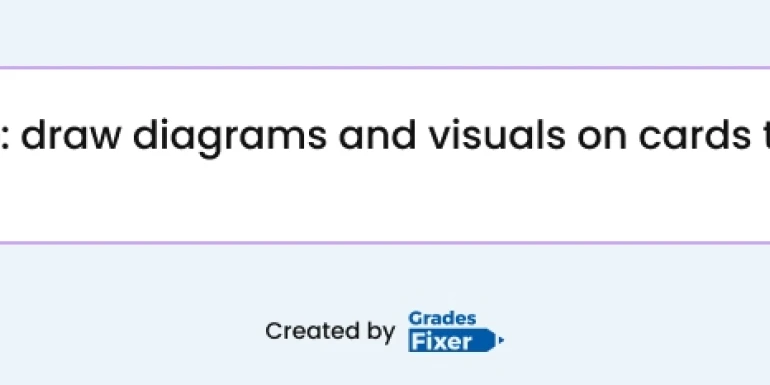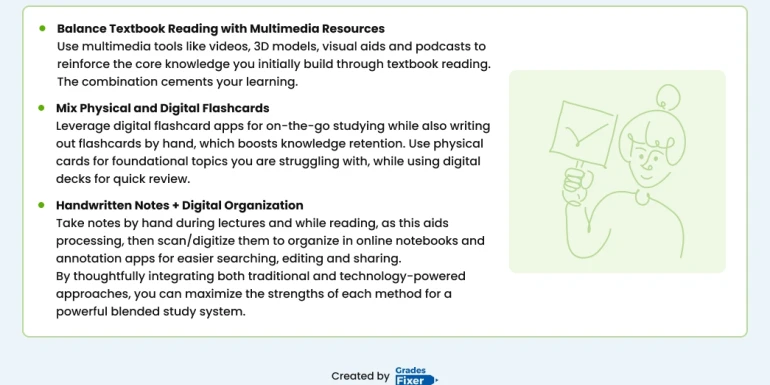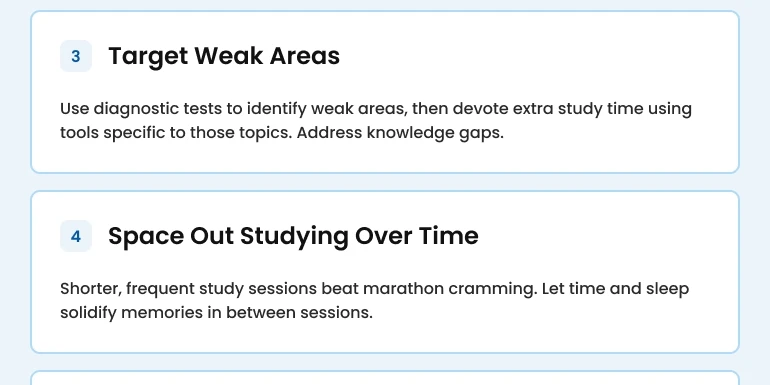As a medical student, having the right study tools at your fingertips is critical to retaining the vast amounts of information you'll encounter and maximizing productivity during your demanding study sessions. With new technology and resources emerging all the time, it can be overwhelming to determine which are the best study tools for medical students in today's landscape.
This definitive guide will provide an ultimate list of the top traditional and tech-powered books, platforms, apps and other indispensable resources to help medical students study smarter during their academic journey and beyond. Read on for recommendations of the highest-yield study tools to build an individualized toolkit that matches your learning preferences and helps you thrive in your medical education.
Traditional Study Tools
Traditional Study Tools Crucial for Building a Strong Foundation. While technology opens exciting new possibilities for medical learning, traditional educational resources for medical students remain essential for building a comprehensive knowledge base. Here are some time-tested tools that all medical students should have in their arsenal.
📚🩺 Must-Have Medical Textbooks
High-quality medical textbooks are vital for gaining in-depth understanding of foundational concepts across core subjects like anatomy, physiology, biochemistry, pharmacology, pathology, and more. While specific recommendations may vary by individual need, some textbooks considered medical student staples include:
- Gray’s Anatomy for Students
- First Aid for the USMLE Step 1
- BRS Physiology
- Lippincott Illustrated Reviews: Pharmacology
- Robbins Basic Pathology
- Guyton and Hall Textbook of Medical Physiology
Be sure your collection includes go-to textbooks for your most challenging subjects. These provide in-depth explanations, fostering a deep understanding of intricate medical subjects that are vital for clinical practice later.Referring to reputable textbooks ensures you learn accurate, comprehensive information.
📚🔍 Must-have Reference Books for Medical Students
In addition to complete textbooks, having condensed reference books on hand for quick review and summary is extremely useful. Some top picks include:
- First Aid for the USMLE Step 1 - High-yield review
- SketchyMedical - Visual mnemonics
- Pocket Medicine - Clinical reference
- Master the Boards - Practice questions
- Step-Up to Medicine - Clinical vignettes
Keep reference books handy for refreshing your memory right before an exam. Their succinct overviews help reinforce your knowledge.
📊🫁 The Value of Anatomy Charts and Models
Visual learning in medicine is non-negotiable. Anatomical charts, models, and other essential medical student resources offer a tangible, 3D perspective, aiding comprehension of body structures. For instance, a heart model can help visualize cardiac chambers and valves, offering clarity unmatched by textbooks alone.
📑🔍 Flashcards to Optimize Spaced Repetition
Flashcards have stood the test of time, and for good reason. The science shows that practicing active recall through flashcards helps reinforce memorization thanks to spaced repetition. Use physical or digital flashcards to repeatedly quiz yourself on terms, concepts, lab values, microorganisms, pharmaceuticals, and more. Make your own or use pre-made decks specifically tailored for medical students. Platforms like Anki and LightYear tailored for med students allow students to curate customized flashcards. For those pressed for time, pre-made decks tailored for med students can be life-savers.
📒🖍 Highlighters and Notebooks to Organize Information
Actively annotating textbooks and taking organized, handwritten notes are proven retention strategies. Invest in a quality set of highlighters in various colors to efficiently mark key passages. Maintain a notebook or binder for each subject to compile notes, diagrams, charts, and study guides in a structured system. Colored highlighters can categorize information while specialized notebooks like the Cornell Method Notebook structure notes for optimal revision. Outlining chapters, condensing study guides, and writing summaries helps solidify learning.
🧠💡 Mnemonics to Aid Memorization
Mnemonics use patterns, acronyms, rhymes, songs and visualization to make large amounts of information easier to remember. Many students create funny or clever mnemonics to recall terms, lists, steps, and more. For example: “Some Lovers Try Positions That They Can’t Handle” to memorize the 12 cranial nerves. Incorporating mnemonics into your study routine helps boost retention.
Digital Study Tools for Today's Medical Students
While traditional methods are still essential, technology opens exciting new possibilities for medical learning. Here are some of the best apps for medical students in the 21st century.
📱📚 Mobile Apps for On-the-Go Learning
With the smartphone boom, portable study is a reality. Apps like Anki for flashcards, Figure 1 for clinical case discussions, Clinical Pharmacology for drug information, VisualDX with Images for 2000+ diseases and Epocrates for disease references have become indispensable for the modern med student.
Mobile apps allow you to reinforce knowledge during pockets of downtime.
🎧📚 Audio Resources to Learn by Listening
Auditory learners can greatly benefit from podcasts, lectures, and audiobooks. Auditory learning leverages passive time, such as commutes. Top medical podcasts like "The Curbsiders" and "Medicine Revision" along with audiobooks transform mundane activities into productive study sessions.
Some stellar options include:
- OnlineMedEd: Lecture series on fundamental topics
- Osmosis: Medical mnemonics and audio review
- Audible: Medical textbooks, test prep books in audio form
Listen to audio resources during your commute, workout, chores, etc.
🎥🩺 Instructional Medical Videos
For visual learners, video content can really drive home concepts. Excellent YouTube channels, video lectures, and video courses include:
- Khan Academy: Medicine and health video library
- SketchyMedical: Visual mnemonics for micro, pharm, path
- Boards and Beyond: Videos on foundational concepts
- Pathoma: Videos explaining pathology concepts
- MedCram: Medical Lectures
Watching educational medical videos is more engaging than just reading.
📲📑 Digital Flashcards and Quizzes for Self-Testing
Testing fosters active recall. In addition to physical flashcards, digital flashcard apps and quiz banks allow you to self-test anywhere. Digital platforms like Quizlet offer flashcards, while question banks like "UWorld" and "Amboss" provide rigorous medical questionnaires tailored for board exams. Use USMLE-Rx Qbank for step exam prep, Picmonic as visual med flashcards with quizzes. Testing one's knowledge is a proven study strategy that tech enables seamlessly.
🕶️📱 Emerging Tech Tools like VR, AR and Digital Notebooks
Immersive learning via VR/AR offers hands-on experiences. Virtual dissections, 3D organ visualizations, and virtual patient interactions are just the tip of the iceberg. Recommendations include "Complete Anatomy" for 3D visualization and the "Microsoft HoloLens" for augmented reality experiences.
Other emerging tech shows promise for medical learning, such as:
- Virtual reality simulations for practicing skills
- Augmented reality anatomy visualization
- Digital notebooks on tablets/laptops with handwriting/drawing capabilities to recreate benefits of paper notes electronically.
As these new technologies develop further, they have high potential to complement traditional learning methods.
💻🎓 Other Online Platforms and Courses
Continuous learning is the essence of medicine. Platforms like Coursera and Khan Academy offer specialized courses that supplement core medical curricula.
These platforms and courses represent some of the best resources for medical students, enabling them to dive deeper into their subjects and excel in their studies.
- MedEd Portal: A free online publication service where medical educators can exchange educational resources and teaching tools. It's a hub for peer-reviewed medical learning modules.
- AnatomyZone: An all-inclusive platform that offers 3D anatomy tutorials. This platform provides students with a comprehensive view of the human body, which is integral for their studies.
- Radiopaedia: A must-visit for those interested in radiology. It's a continually updated radiology resource, boasting a vast collection of images and cases.
- Medbullets: A dynamic approach to medical education, Medbullets offers a series of high-yield content review and question banks for various medical exams.
- Dr. Najeeb Lectures: Known for their comprehensive content, these lectures cover a broad range of topics in medicine, explaining even the most complex of concepts with ease.
- First Aid Series: While not purely an online platform, the digital editions of the First Aid series, especially 'First Aid for the USMLE', are considered gold standards in the medical student community.
- BMJ Learning:Offers high-quality continuing medical education for doctors and other healthcare professionals.
- Clinical Problem Solving: A course designed to help medical students develop their clinical problem-solving skills.
- Introduction to Systematic Review and Meta-Analysis: Suitable for students looking into research, this course teaches how to perform systematic reviews and meta-analyses.
- Understanding and Improving US Healthcare: Explores the US healthcare system, its problems, and potential solutions.
- Essential Human Biology: Cells and Tissues: Offers an in-depth look at human cells and tissues for students wanting to solidify their foundational knowledge.
- AnatomyX: Musculoskeletal Cases (Harvard University via edX): A deep dive into musculoskeletal anatomy using clinical case studies.
- Medical Neuroscience: Covers the organization and functions of the human central nervous system.
- Vital Signs: Understanding What the Body Is Telling Us: Offers insights into the crucial physiological measurements of the human body.
Combining: Traditional + Digital Resources
Rather than treating tech and traditional tools as an either/or scenario, the most effective approach for leveraging the best medical school resources combines both domains to maximize your learning. Here are some key benefits of integrating analog and digital tools:
Tips to the Efficiency of Your Study Tools
To really optimize your chosen study tools, keep these research-backed tips in mind:
By adjusting these key variables, you can get far more value from your go-to study tools.
Conclusion and Final Recommendations
In summary, today's medical students have an enriched set of both traditional and technology-powered study resources at their fingertips. Building a personalized toolkit that balances the strengths of books, multimedia, flashcards, visual aids, practice questions, and even the right medical student app based on your individual needs and learning preferences is key to excelling at this demanding stage of your medical education.
Put together your optimal bundle of resources, focus on active learning, target weak spots, and stay consistent. With the right set of tools and techniques, you are set up for success throughout your medical training.
Remember, the ultimate goal is to not just pass exams but to become a proficient physician. Choose wisely, study smartly, and excel!
Resources
- https://www.mua.edu/resources/blog/free-resources-for-medical-students
- https://www.oscebank.com/blog/top-10-online-resources-for-medical-students
- https://studentlife.lincoln.ac.uk/2021/10/12/the-best-free-resources-for-medical-students/
- https://www.prospectivedoctor.com/10-resources-for-your-pre-clinical-med-school-years/
- https://www.joyce.edu/blog/onlines-resources-healthcare-students/
- https://www.aamc.org/career-development/affinity-groups/gea/first-generation-students








